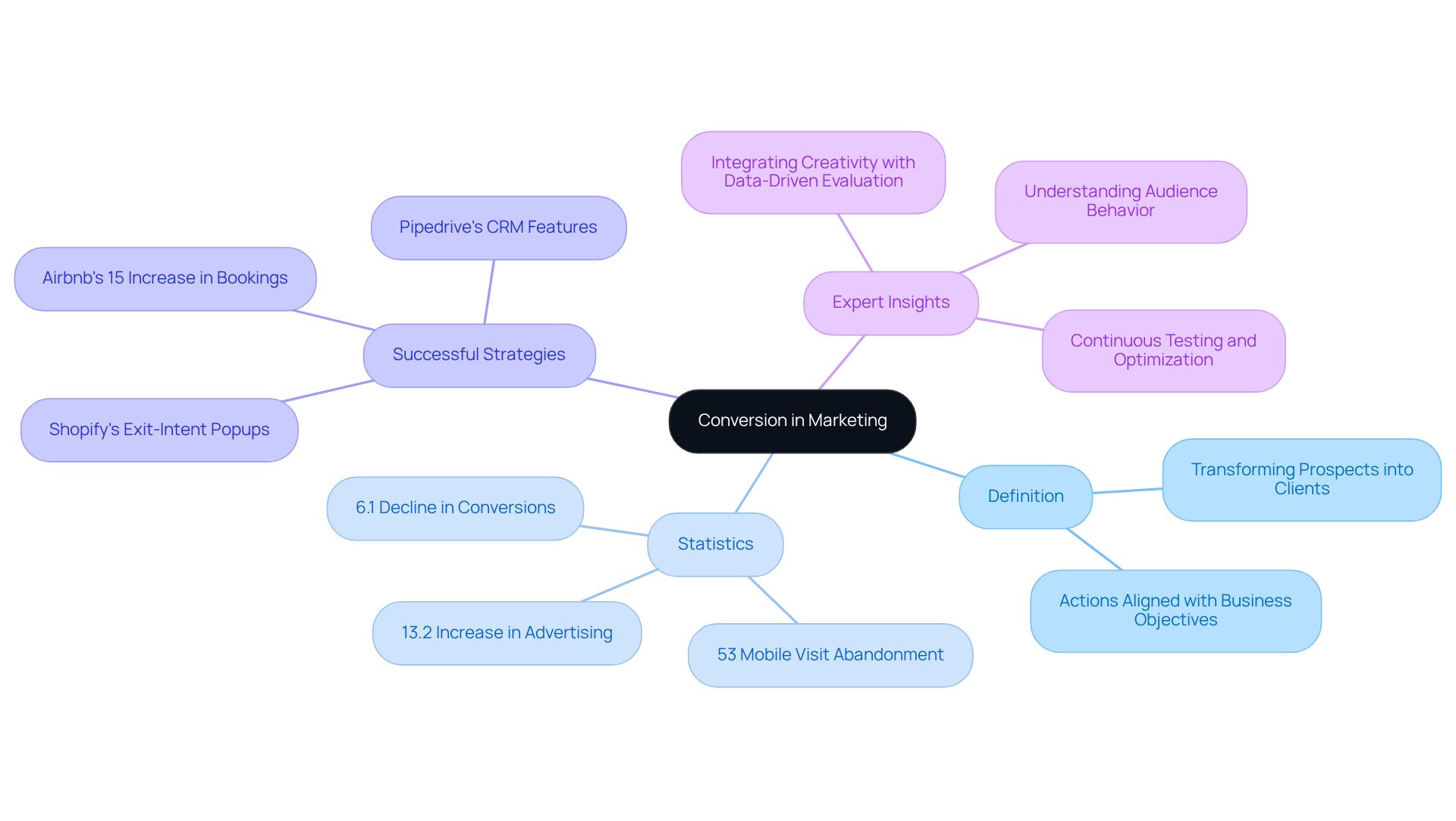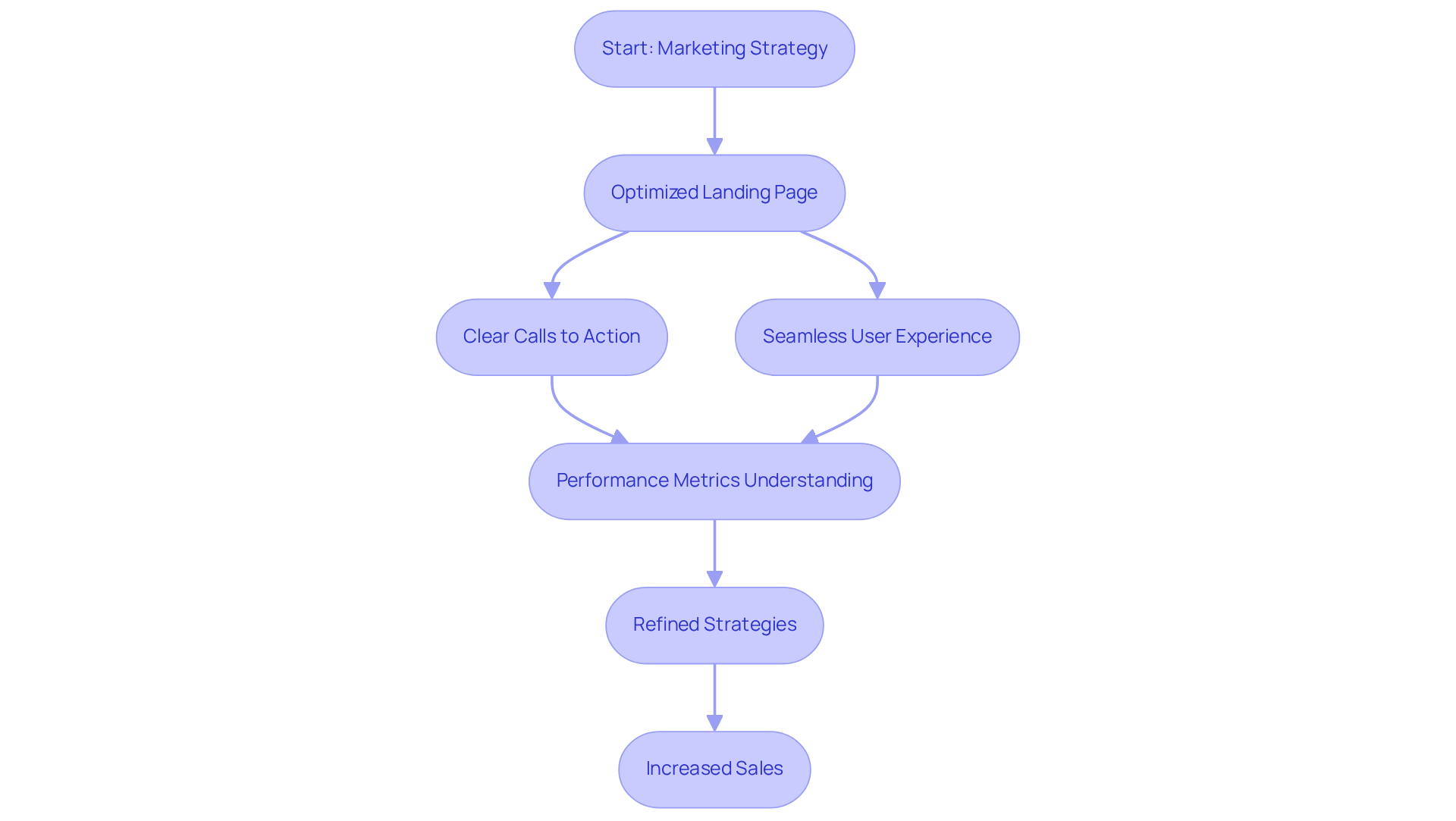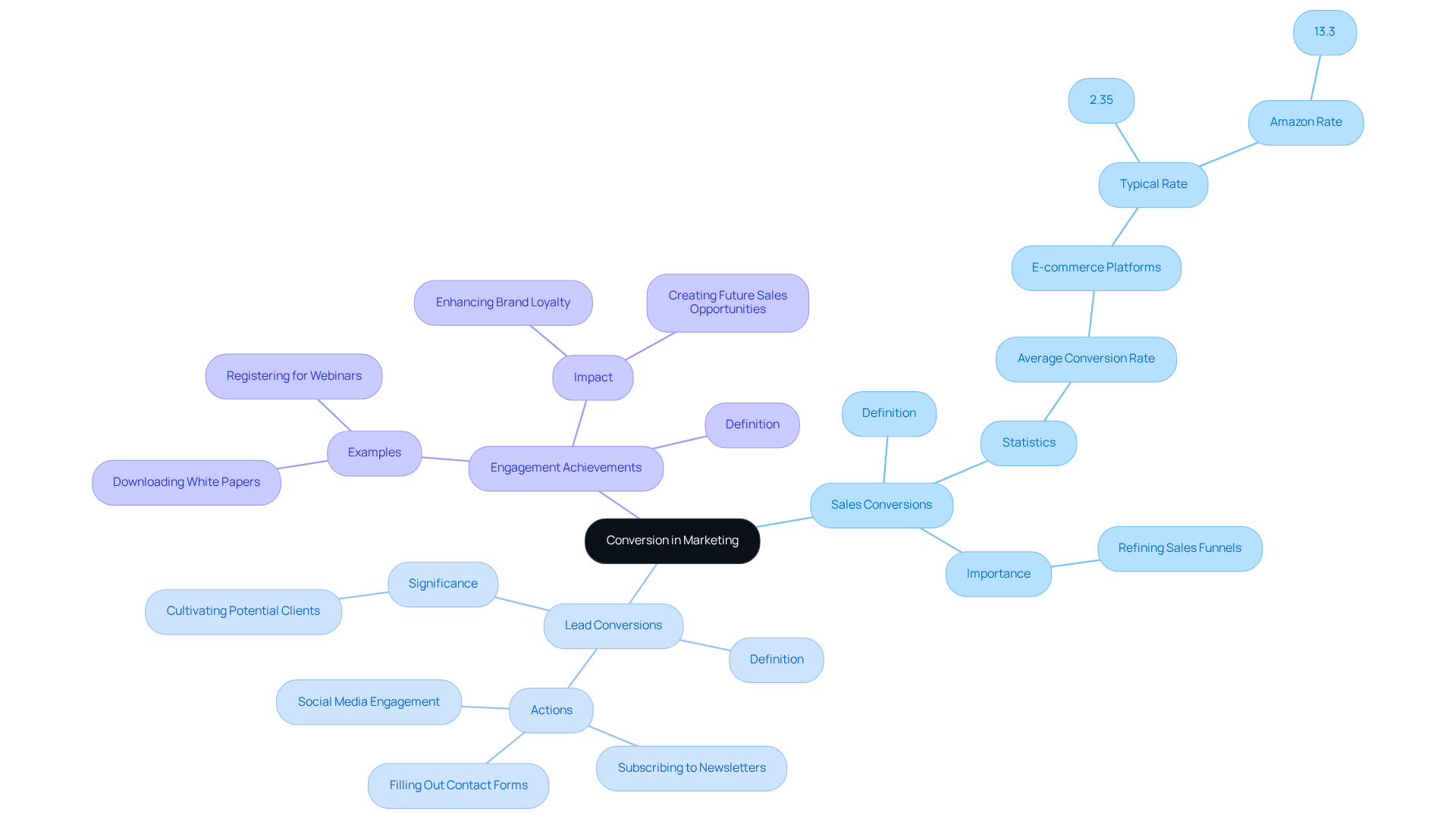
Overview
This article delves into the pivotal concept of conversion in marketing, asserting its critical role in transforming potential clients into actual customers through decisive actions, such as purchases or sign-ups. It underscores the necessity of effective strategies, including:
- Personalized communication
- Optimized user experiences
These strategies have been proven to significantly enhance conversion rates and drive overall marketing success.
Introduction
Understanding the nuances of conversion in marketing reveals a fundamental aspect of how businesses engage with their audiences. This concept transcends mere transactions; it encompasses the journey of transforming potential customers into loyal advocates through targeted actions. As marketers navigate an increasingly digital landscape, the pivotal challenge remains: how can they effectively optimize their strategies to not only capture attention but also drive meaningful engagement? Delving into the role of conversion unveils essential insights that can revolutionize marketing efforts and enhance overall success.
Defining Conversion in Marketing
In promotion, achieving another word for conversion means transforming a prospective client into a real client by encouraging them to undertake a specific action aligned with business objectives. This action can range widely, from making a purchase to signing up for a newsletter or downloading a resource. Essentially, another word for conversion takes place when a visitor to a website or a recipient of a marketing message responds positively to a call-to-action (CTA). Grasping this concept is vital for marketers, as it directly influences the effectiveness of their campaigns and overall business success.
Statistics underscore the significance of change: brands increased their digital advertising expenditure by 13.2% in 2024, yet faced a 6.1% decline in results, highlighting the urgent need for more efficient approaches. Moreover, 53% of mobile visits abandon pages that require over three seconds to load, emphasizing the critical nature of user experience in driving results.
Successful case studies illustrate effective strategies for another word for conversion. For instance, Airbnb achieved a 15% increase in bookings and a 20% rise in click-through rates by utilizing personalized emails based on client behavior, demonstrating how tailored communication can re-engage customers. Similarly, Shopify's implementation of exit-intent popups has been shown to boost purchase rates by 2-4%, effectively encouraging users to complete their transactions without disrupting their browsing experience.
Citations from industry experts further accentuate the importance of another word for conversion in promotion. One expert notes that transformative promotion integrates creativity with data-driven evaluation to identify campaigns that directly enhance revenue and ROI. This approach is essential in today’s competitive landscape, where understanding and can lead to sustainable growth and profitability.

The Importance of Conversion in Marketing Strategies
Another word for conversion is a cornerstone of effective promotional strategies, directly correlating with revenue generation. A high success rate indicates that a marketing campaign is successfully persuading visitors to take desired actions, leading to increased sales and enhanced customer loyalty.
For instance, a well-optimized landing page can significantly elevate response rates by providing clear calls to action (CTAs) and ensuring a seamless user experience. Moreover, understanding empowers marketers to refine their strategies, allocate resources more efficiently, and ultimately achieve a greater [return on investment (ROI)](https://parahgroup.com).

Historical Context and Evolution of Conversion
The evolution of change in promotion has undergone a profound transformation since the inception of advertising. Initially, this process was narrowly defined, focusing primarily on direct sales through traditional media such as print and television. However, the emergence of digital promotion has significantly expanded this definition to include a diverse array of online actions, including clicks, sign-ups, and downloads. This pivotal shift has been greatly influenced by the advent of , which have revolutionized how marketers evaluate and enhance outcomes, facilitating data-driven decision-making.
Today, optimization represents a multifaceted discipline that merges user experience design, behavioral psychology, and advanced analytics to elevate the effectiveness of promotional strategies. A prime example of this evolution is [Parah Group's approach to another word for conversion Rate Optimization (CRO)](https://parahgroup.com). By leveraging data-centric methodologies and gaining insights into consumer behavior, they have achieved remarkable results for their clients, including a 36% increase in ROI on advertisements and substantial improvements in average order values and sales rates. This holistic approach not only aligns various components of a client's website and promotional strategy but also addresses the pressing need for brands to optimize their existing resources within a competitive landscape.
As online promotion continues to evolve, the metrics employed to evaluate another word for conversion are likely to expand further, reflecting the dynamic nature of consumer engagement and the increasing complexity of the digital marketplace. Marketers now bear the responsibility of understanding the intricate paths consumers navigate before making a purchase, necessitating a more sophisticated strategy for measurement and optimization. As Shubhi Ahluwalia, a content promotion expert, aptly notes, "achieving success in transformation strategies is a repetitive process that relies significantly on the level of effort you invest in comprehending your audience, crafting an engaging narrative, and providing delightful experiences." Moreover, with mobile load times averaging 27.3 seconds, the impact on sales rates cannot be overlooked, underscoring the imperative for brands to prioritize user experience in their optimization initiatives.

Examples of Conversion in Marketing
In marketing, another word for conversion manifests in various forms, each aligned with specific campaign objectives. Key types include:
- Sales Conversions: This occurs when a visitor completes a purchase on an e-commerce platform, marking them as a converted customer. The typical transformation rate for e-commerce platforms is roughly 2.35%, whereas Amazon features a rate of about 13.3%. This disparity emphasizes the significance of refining sales funnels to boost revenue.
- Lead Conversions: When a user fills out a contact form or subscribes to a newsletter, they transition into a lead, indicating their interest in the brand. This transformation, which can be described as another word for conversion, is essential for cultivating potential clients and directing them through the sales process. Gentle actions, such as subscribing to a newsletter or sharing a post on social media, also contribute significantly to fostering long-term engagement.
- Engagement Achievements: Actions like downloading a white paper or registering for a webinar are regarded as achievements, as they demonstrate user involvement with the brand. These interactions can significantly enhance brand loyalty and create future sales opportunities.
Instruments such as Google Analytics and Facebook Pixel are crucial for monitoring these changes, enabling marketers to assess success and enhance their approaches efficiently. Understanding these conversion types, considered another word for conversion, empowers marketers to effectively, ensuring they meet their goals and optimize their campaigns for superior performance.

Conclusion
Understanding the nuances of conversion in marketing is vital for any business striving to excel in a competitive environment. Conversion transcends mere sales; it embodies a spectrum of actions that reflect engagement and commitment from potential customers. By redefining conversion through various lenses—sales, leads, and engagement—marketers can strategically enhance their efforts to foster meaningful interactions.
Key insights emphasize the urgent need for brands to evolve their marketing strategies in response to shifting consumer behaviors and technological advancements. The importance of user experience and the effectiveness of personalized communication emerge as critical factors. The evidence presented illustrates that successful conversion strategies are anchored in a profound understanding of customer needs and preferences. Case studies from companies like Airbnb and Shopify illustrate how tailored approaches can yield significant improvements in conversion rates.
Ultimately, the importance of conversion in marketing extends beyond immediate sales; it establishes the foundation for enduring customer relationships and brand loyalty. As the digital landscape evolves, marketers must prioritize the optimization of their conversion strategies to not only meet but surpass customer expectations. Embracing a data-driven approach and continuously refining tactics will be essential for achieving sustainable growth and profitability in today’s dynamic marketplace.
Frequently Asked Questions
What does "conversion" mean in marketing?
In marketing, conversion refers to the process of transforming a prospective client into a real client by encouraging them to undertake a specific action aligned with business objectives, such as making a purchase, signing up for a newsletter, or downloading a resource.
What is a call-to-action (CTA)?
A call-to-action (CTA) is a prompt that encourages a visitor to a website or a recipient of a marketing message to take a specific action, which is essential for achieving conversion.
Why is understanding conversion important for marketers?
Understanding conversion is vital for marketers because it directly influences the effectiveness of their campaigns and overall business success.
What statistics highlight the importance of conversion in marketing?
In 2024, brands increased their digital advertising expenditure by 13.2% but faced a 6.1% decline in results, emphasizing the need for more efficient approaches. Additionally, 53% of mobile visits abandon pages that take over three seconds to load, indicating the critical nature of user experience in driving results.
Can you provide examples of successful conversion strategies?
Yes, for example, Airbnb achieved a 15% increase in bookings and a 20% rise in click-through rates by using personalized emails based on client behavior. Shopify's use of exit-intent popups has also been effective, boosting purchase rates by 2-4% by encouraging users to complete transactions without disrupting their browsing experience.
What do industry experts say about conversion in promotion?
Industry experts emphasize that effective promotion integrates creativity with data-driven evaluation to identify campaigns that enhance revenue and ROI, which is essential for sustainable growth and profitability in a competitive landscape.
FAQs











